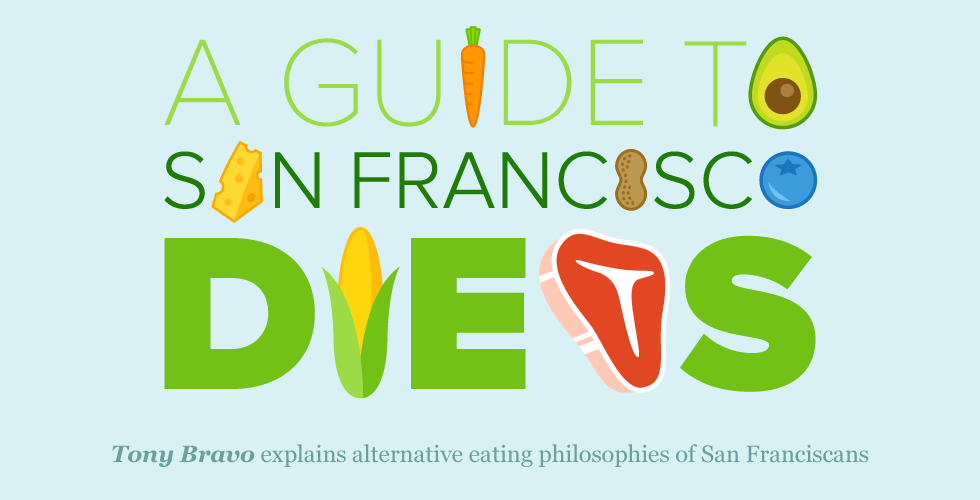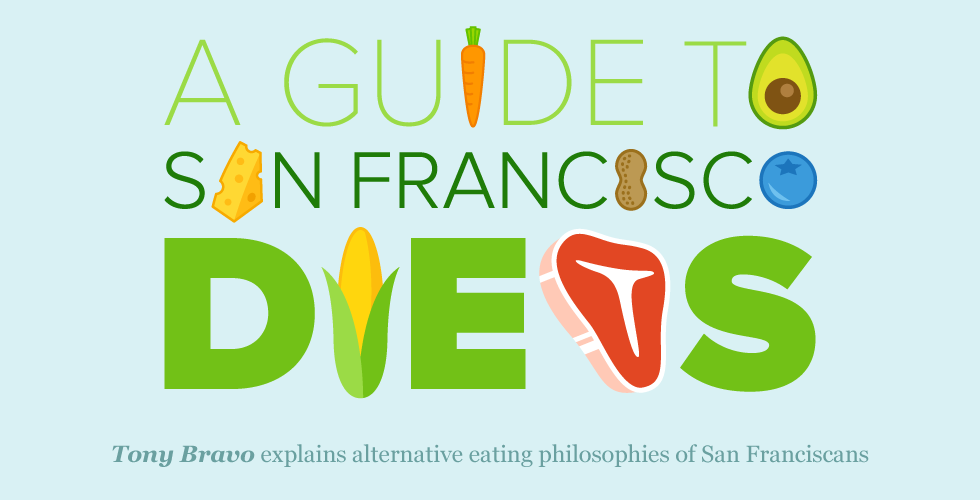
Some cities are proud of their regional cuisine. Here in the Bay Area, we’re proud of our regional-cuisine restrictions. Ask your average San Franciscan. The majority of us are on less-than-friendly terms with at least one subcategory of food, if not an entire food group, whether due to allergies, religious affiliations or lifestyle choices. We’ve all been to a restaurant or a dinner party with a friend who resorts to nibbling on garnishes because his new “alternative eating philosophy” (that’s the way people who took grad school too seriously say “diet”) could not be accommodated. YET. The following is helpful for the uninitiated — a guide to eating trends you may encounter out on the town or possibly in your own kitchen.
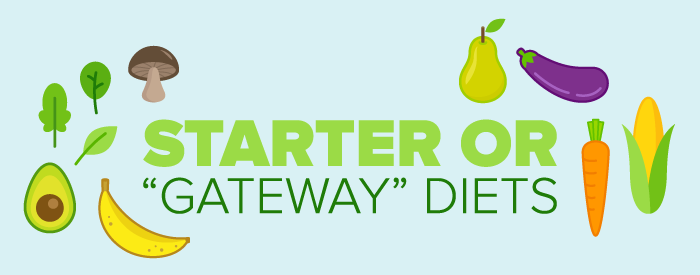
These are what I like to think of as the “starter” restrictions. I sometimes also refer to these diets as the “gateway” diets since today’s vegetarian might be tomorrow’s locavore or flourless eater.
Vegetarianism is an easy one; it’s a diet without meat. Most people are familiar with and can easily accommodate vegetarians. The exception here will always be relatives over the age of 80 or those born in carnivore hotspots. No matter what, they will continue to offer you chicken since “it doesn’t really count, does it?”
Veganism excludes meat, dairy and eggs. This diet has been around long enough that all San Franciscans have at least one friend whom they’re used to accommodating. Former president Bill Clinton has become one of the higher-profile vegans during the last few years, which is great for people who were tired of Alicia Silverstone hijacking the face of the movement.
People turn to vegetarianism and veganism for all kinds of reasons, but the two main ones are health consciousness and ethical/political objections to consuming animal products. The ethical/political veggies are a lot of fun. Remember your cousin who cried when your aunt served veal because she could “feel the cutlet’s suffering”? That’s a good example of an ethical veggie and a bad example of a dinner guest.
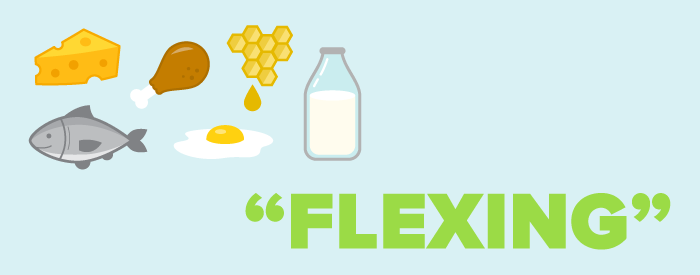
For some, vegetarianism comes on a sliding scale.
Pescetarians eliminate meat from their diets but still eat fish.
Pollotarians will still eat chicken and other poultry but not meat from non-feathered mammals.
Pesce-pollotarians eat seafood and poultry but abstain from red meat and pork.
I’ve always considered the pesces and pollos to be the lame younger siblings of dietary restrictions. Do people who eat just poultry and seafood really get to call themselves something special? They say yes. I say, call me when you have the willpower to forgo an entire food group. These vegetarian subsets sometimes like to categorize themselves under the banner of flexitarianism, which is just as lacking in commitment as it sounds.
Let’s not even get started on ovo-vegetarians, lacto-vegetarians, lacto-ovo-vegetarians and people with rules about honey.
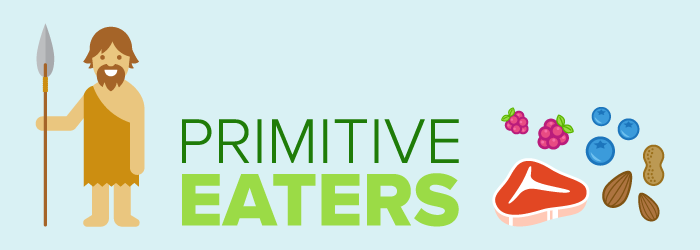
One of my favorite diets to recently inflict itself on humanity is the paleolithic diet, or paleo. This food philosophy says that we should eat what our ancestors ate. No, this does not mean our ethnic ancestors, so I will not be able to subsist solely on cannoli and Carmignano vintages. Paleos eat what the earliest humans ate and exclude gluten, dairy and root vegetables in favor of things that can be hunted and gathered like our caveman forbearers used to do. For this reason, whenever a friend tells me they’re into paleo, I like to start singing the theme song from The Flintstones.
I like the idea behind the paleo diet: we should remove the cultivated foods that weren’t from early man’s original diet. But there’s disagreement over what exactly our ancestors ate and what a true paleo diet should be. If you ever have a hard-core paleo over to dinner, here’s what I recommend you do: Give them a basket and a spear, set them loose in Golden Gate Park, and tell them to let their instincts take over. If a true paleo wants to eat like early man, isn’t it a little hypocritical to grab preboxed grub at Real Foods?

Alkaline diets haven’t been on the radar much lately, but after spending a luncheon watching an alka friend mix and match possible food combinations, I think it’s due for a comeback. Alkaline diets operate under the philosophy that specific foods and food combinations can affect the acidity of the body’s fluids and that keeping your body’s pH balance in proper order is the key to health.
Basically, it’s the food version of when that guy comes out to test the chemical levels of your pool with that little stick that turns different colors, and then accordingly, he adds chlorine. It’s not so much a diet of restrictions as one of endless food-diary entries and consulting charts to tell you whether the mandarin orange you ate has more acidity than a tangerine. Since it’s a diet high in math and chemistry, I imagine it attracts the types of people who really liked science-fair projects as a kid.

As you probably know, gluten intolerance (also known as celiac disease) has recently replaced adult ADHD as the malady du jour for a certain segment of the population. Genetic tampering with wheat by food scientists for the last hundred years has perverted the original makeup of it so much that more people than ever before are developing gluten sensitivity or intolerance. At least that’s what your friends with the condition will say in order to try to darkly hint that you may also have it. The remedy for celiac disease is the flour-free diet.
If you think older people have a hard time grasping the finer points of vegetarianism and veganism, wait until you get asked for the eighth time at Thanksgiving, “Honey, what exactly is ‘a gluten’?”
For the flour-free, always remember: brown rice is your best friend. Also, did you know there are a lot of non-gluten oat and grain options? Maybe by the time this runs, it’ll be OK to eat quinoa again. Here’s the downside: gluten and white flour are America’s other corn, meaning they’re secretly in everything. If you’re trying to make your first gluten-free meal, read labels. You’d be surprised by how many things you’d never suspect are not friendly to gluten-free diets. For example: soy sauce, vegetable and chicken broth, couscous and most envelope adhesives. I’m disappointed by the news about envelope adhesives since, in a pinch, they can make a nice palate cleanser between courses.

If you live in the Bay Area, there’s a 65 percent chance you’ve done a food cleanse. If you live in San Francisco proper, the percentage is closer to 70. If you live in the Mission, you’re probably on one now. Food cleanses are occasional, ultra-restricted diets meant to eliminate toxins and recalibrate your system. Among the most popular is the master cleanse, a 14-day fast whereby you subsist on lemon juice spiked with maple syrup and cayenne pepper. If you or someone you know is currently on a master cleanse, I’m sorry. Beware of days eight through 14, when you start to hallucinate that people’s faces are puff pastry, and your inner Hannibal Lecter begins to reveal itself.

I’ve saved two of my favorites for last: they’re not just diets; they’re “movements.”
Locavores are close to my heart. You know what else locavores are close to? The food they eat. Eating locally not only supports small farms and offers the benefits of fresher food, but the less traveling your food does to get to you, the fewer carbon emissions you’re creating. It’s a concept I’m all in favor of. I’m growing my own gin in solidarity. I recently had a locavore friend to tea and served him a lovely selection of clippings from my garden tossed in a light vinaigrette of artisan balsamic. But Tony Bravo, I can hear you say, you don’t have an edible garden. While the edibility might be in question, no one can dispute the locally grown credentials of the lawn 20 feet outside my kitchen.
Freeganism is another food movement based 0n environmental and political concerns. Freegans are basically dumpster divers for political purposes. They believe a lot of perfectly edible food is thrown away, so they “reclaim” it from said dumpsters—and voilà, dinner. At that same tea with my locavore friend, wouldn’t you know that a freegan acquaintance happened to stop by. I was in a panic over what to serve, but after a little quick thinking, I emptied my compost bin onto a Limoges plate, and he was as happy as could be.
As Julia Child would say (probably under extremely different circumstances):




